Wildflowers of the Adirondacks:
Wild Columbine (Aquilegia canadensis)
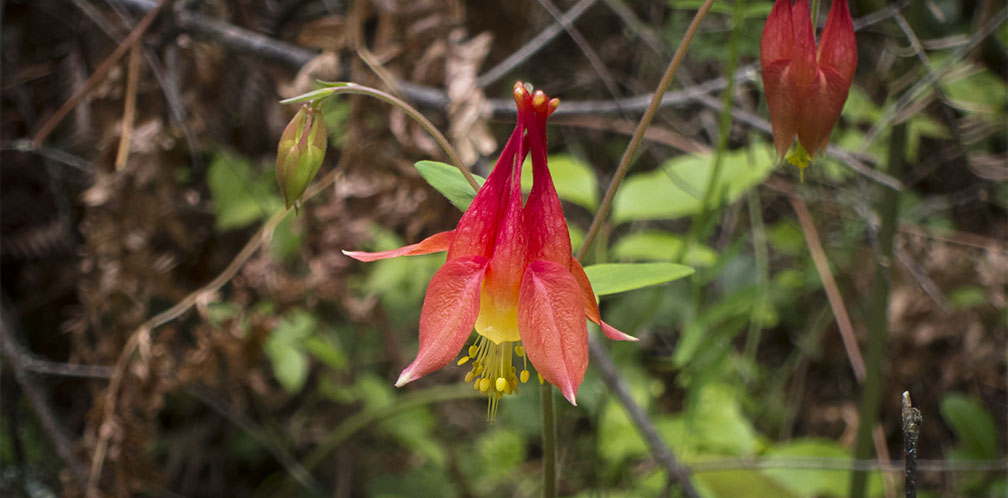
Wild Columbine (often referred to as Red Columbine) is a native Adirondack wildflower which produces showy red and yellow flowers in late spring and summer in the Adirondack Mountains of upstate New York. Its compound leaves are divided into threes, with three irregular lobes.
Wild Columbine (Aquilegia canadensis) is a member of the Ranunculaceae (Buttercup or Crowfoot) family – a very large family that includes other Adirondack wildflowers such as Goldthread, White Baneberry, Red Baneberry, and Tall Meadow Rue. Wild Columbine is one of 21 species in the Aquilegia genus Only one other (Aquilegia vulgaris) occurs in New York State; this plant is not native, having been introduced from Europe. The other Aquilegia species are found out west or in the southwest, most in very small areas.
- The genus name (Aquilegia) is derived from the Latin word "aquila," which means eagle; some believe that the petals resemble an eagle's talons. An alternate theory about the origin of the name suggests that it is from the Latin aquarius, meaning “water carrier” – a reference to the nectar that collects in the spurs. The species name (canadensis) refers to its presence in Canada.
- The origin of the common name (Columbine) is unclear. One source suggests that it derives from the Latin term for dove (columba); the shape of the petals supposedly represents the figure of a dove.
Wild Columbine has a long list of non-scientific names. Many sources refer to it as Red Columbine. Other names include American Columbine, Canadian Columbine, Cluckies, Colorado Columbine, Columbine, Common Columbine, Dancing Fairies, Eastern Red Columbine, Granny’s Bonnets, Honeysuckle, Jack-in-trousers, Meeting Houses, Meetinghouses, Meeting-houses, Northern Bush-honeysuckle, Red-bell, Red-bells, Rock Lily, Rock-bells, Rock-lily, Wild Red Columbine, and Wild-honeysuckle.
Identification of Wild Columbine
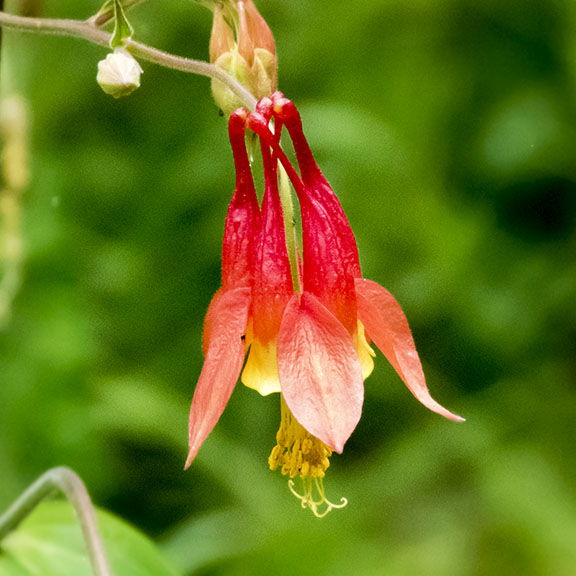
Wild Columbine is a perennial plant.
- It grows one to three feet tall and 12 to 18 inches wide.
- Wild Columbine has a short, erect underground stem (called a caudexCaudex: The thickened, usually underground base of the stem of many perennial herbaceous plants, from which new leaves and flowering stems arise.) and fibrous, short-lived roots.
- The aboveground portions of the plant die back to the caudex in mid- to late autumn.
The plant is erect; the upper part of the plant is branched, but not densely so. The stems are green to reddish green and may be slightly hairy on the upper part of the plant (near the flower).
Wild Columbine leaves are compound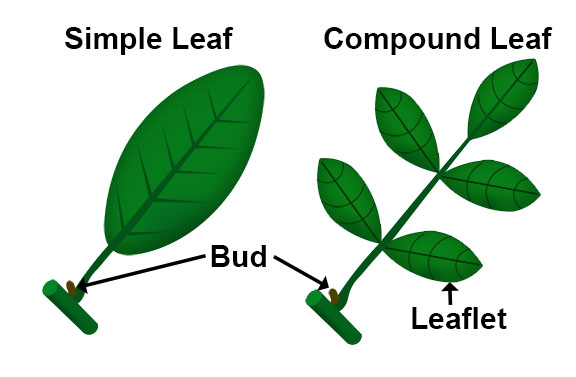 Compound Leaf: A leaf that is divided to the midrib, with distinct, expanded portions called leaflets., which means that its leaves form distinct leaflets on a common leaf stalk. The leaves are typically divided into threes, each of which have three irregular, rounded lobes. The basal leaves (the leaves that emerge from the base of the plant) are larger than the stem leaves. The basal leaves have long stalks. The leaves on the upper stem are alternate
Compound Leaf: A leaf that is divided to the midrib, with distinct, expanded portions called leaflets., which means that its leaves form distinct leaflets on a common leaf stalk. The leaves are typically divided into threes, each of which have three irregular, rounded lobes. The basal leaves (the leaves that emerge from the base of the plant) are larger than the stem leaves. The basal leaves have long stalks. The leaves on the upper stem are alternate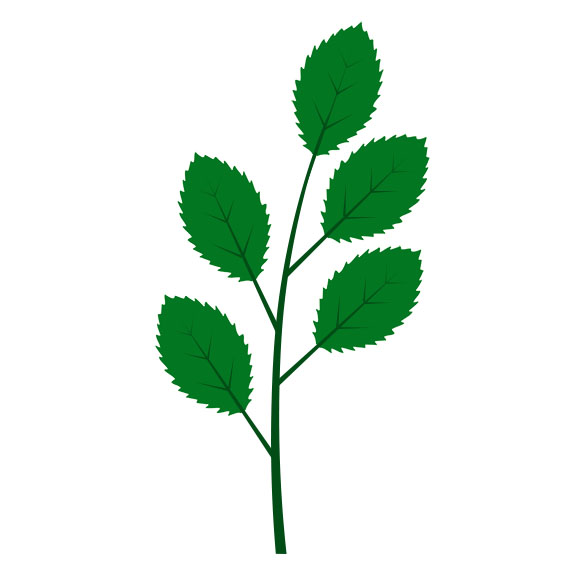 Alternate: An arrangement of leaves (or buds) on a stem (or twig) in which the leaves emerge from the stem one at a time. This often makes the leaves appear to alternate on the stem. (meaning that they emerge from the stem one per node) and smaller with short or no stalks.
Alternate: An arrangement of leaves (or buds) on a stem (or twig) in which the leaves emerge from the stem one at a time. This often makes the leaves appear to alternate on the stem. (meaning that they emerge from the stem one per node) and smaller with short or no stalks.
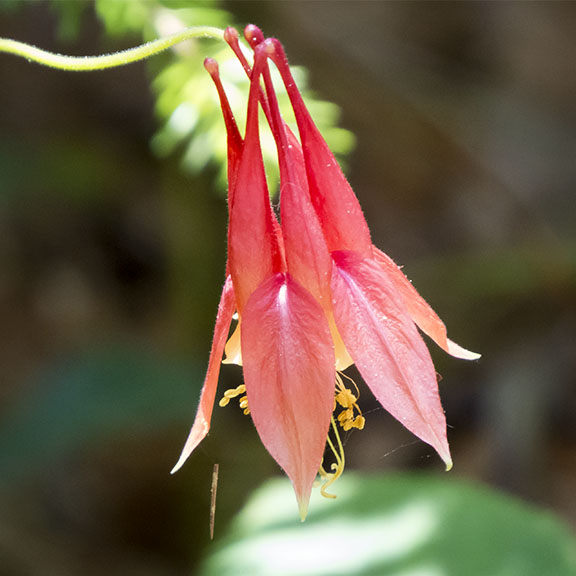
Wild Columbine produces tubular flowers which hang downwards, dangling from long stems.
- Each of the yellow-tipped petals extends backwards into long red spurs. Each spur has a slightly bulbous tip called a nectary where (as the name implies) nectar is stored.
- The flower has five flaring, petal-like sepals
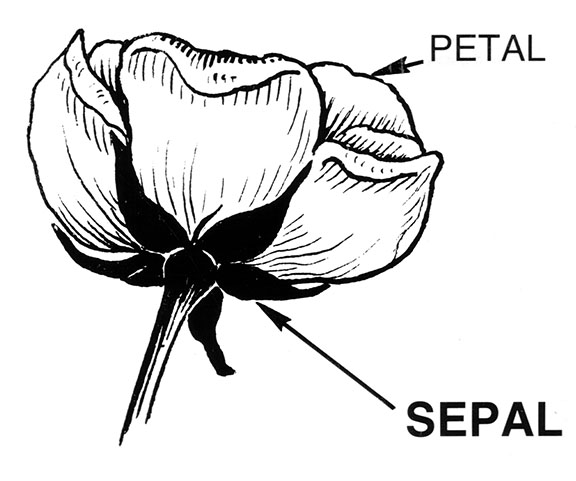 Sepal: One of the usually separate, green parts that surround and protect the flower bud and extend from the base of a flower after it has opened.; the sepals are reddish in color with yellow, rounded tips.
Sepal: One of the usually separate, green parts that surround and protect the flower bud and extend from the base of a flower after it has opened.; the sepals are reddish in color with yellow, rounded tips. - Hanging down from the bottom of the bell is a bundle of many long stamens
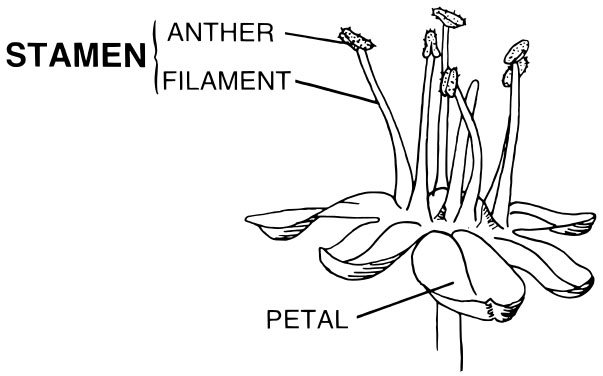 Stamen: The male part of the flower, made up of the filament and anther. with bright yellow anthers
Stamen: The male part of the flower, made up of the filament and anther. with bright yellow anthers.jpg) Anther: the part of a stamen that contains the pollen..
Anther: the part of a stamen that contains the pollen.. - The flowers are about 1½" long from the tip of the spur to the tip of the stamens.
Wild Columbines are listed in most sources as late spring and early summer bloomers. Just south of the Adirondack Park Blue Line, this wildflower usually starts blooming in very early May. In the Adirondack Mountains, you can find Wild Columbine in bloom in mid- to late May in the foothills of the Adirondacks and the southern part of the Adirondack Park. In the northeastern areas, bloom times may be a few weeks later, depending on the weather and the site.
The fruit of Wild Columbine consists of erect green capsules, each ½ to 1 inch long, which mature to brown. Each capsule splits open to release many shiny, black seeds. Seed release usually occurs in early- to mid-autumn.
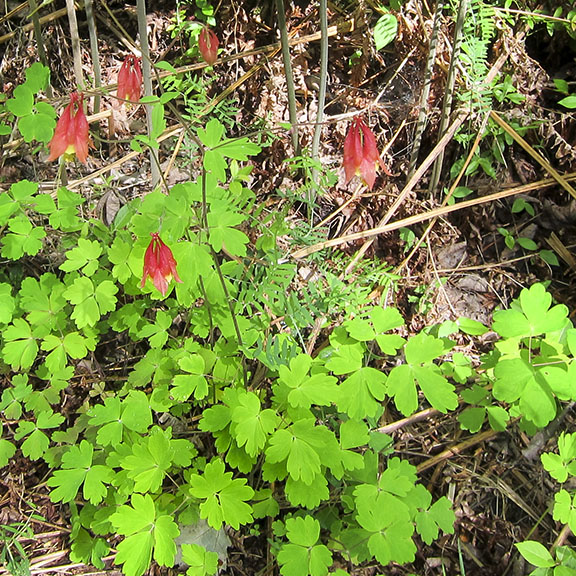
Wild Columbine leaves are somewhat similar to those of Tall Meadow Rue (Thalictrum pubescens) and Blue Cohosh (Caulophyllum thalictroides), both of which are also found in the Adirondack Mountains.
- The starry, white flowers of Tall Meadow Rue are very different from Wild Columbine's showy red and yellow blooms. In addition, the leaflets of Tall Meadow Rue, although they have similar rounded lobes, are smaller than those of Wild Columbine.
- Wild Columbine's compound leaves are also somewhat similar to those of Blue Cohosh (another plant found in the Adirondacks), but the leaflets of the latter plant have more pointed lobes and a bluish cast.
Wild Columbine can be distinguished from European Columbine (Aquilegia vulgaris) by the color and structure of the flowers.
- European Columbine has blue, violet, pink or white flowers.
- Another distinguishing characteristic is the length of the spurs; garden columbines which are hybrids from the European species tend to have very short hooked spurs, in contrast to the long straight spurs of Wild Columbine.
Uses of Wild Columbine
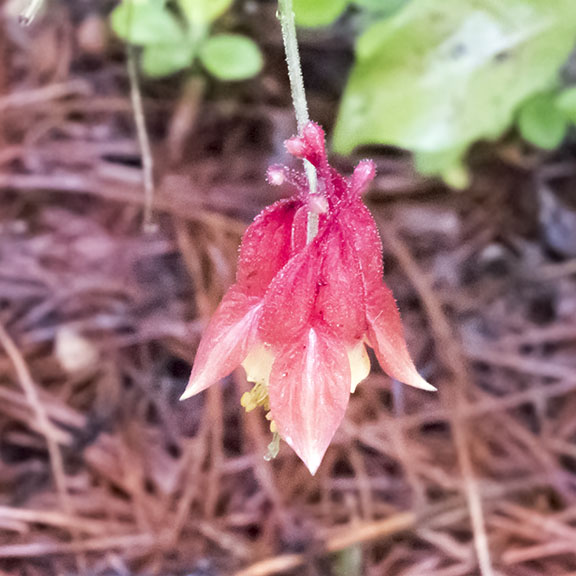
Wild Columbine has been used in a variety of folk remedies. North American Indians reportedly crushed the seeds to use as a headache remedy. They are also said to have prepared infusions from various parts of the plant as a treatment for heart trouble, poison ivy, kidney problems, headaches, bladder problems, and fever. Several sources, however, caution against the use of this plant as a home remedy, since the plant belongs to a family that includes a number of toxic species.
Other uses of Wild Columbine include boiling the plant as a hair wash. In addition, the crushed seed is said to be pleasantly aromatic and has been used as a perfume. Native Americans reportedly rubbed the crushed seeds on the hands of men as a love charm.
Wildlife Value of Wild Columbine
Because the foliage of Wild Columbine is toxic, it is generally unpalatable to mammals. However, the flowers of this wildflower provide nectar that attracts hummingbirds and bumblebees, while the foliage provides food for a variety of insects.
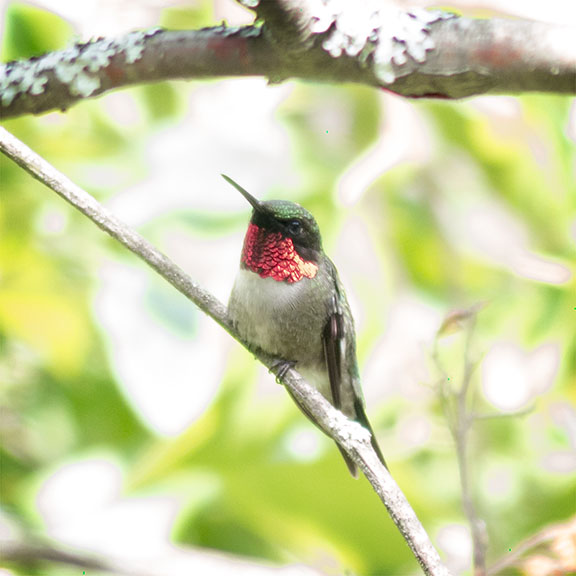
The primary bird consumer of Wild Columbine's nectar is the Ruby-throated Hummingbird. These tiny birds seem to prefer red tubular flowers, and Wild Columbine's bloom time coincides with the arrival of hummingbirds from their wintering grounds to the south. Moreover, the nectar from Wild Columbine is dilute, containing about 20-23% sugar, which is typical of hummingbird flowers.
Sources conflict, however, on the importance of Wild Columbine to the Ruby-throated's diet and the extent to which the Wild Columbine depends on the hummingbird for pollination. Although many sources list Wild Columbine as one of the major food items for the Ruby-throated, one recent study suggests that Wild Columbine is only infrequently visited by hummingbirds.
Wild Columbine also provides food for a variety of insects.
- The plant's flowers attract long-tongued insects, including bumblebees, who visit the flowers for nectar and may also collect pollen for their larvae. Short-tongued bumblebee species, lacking the equipment needed to reach the nectar through the long tubular petals, may nip holes in the nectaries from the outside.
- Wild Columbine is the primary host plant for the Columbine Duskywing butterfly.
- The larvae of several insects feed on Wild Columbine, including the Columbine Sawfly, the Columbine Leafminer, and several borer moth species.
Distribution of Wild Columbine
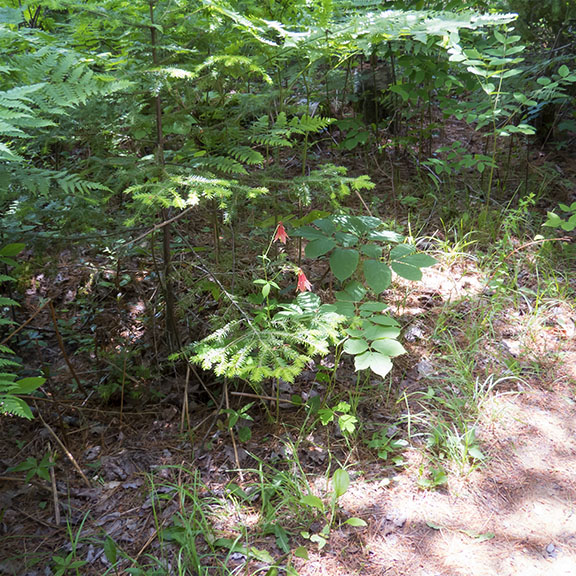
Wild Columbine is found in the eastern two-thirds of the US and the southern provinces of eastern Canada, from Nova Scotia to Saskatchewan, south to northern Florida, western Oklahoma, and eastern Texas. This plant is listed as Endangered in Florida.
Wild Columbine occurs in most counties in New York State. It has been documented in all Blue Line counties except Franklin, Hamilton, and Herkimer counties.
Habitat of Wild Columbine
Wild Columbine can grow in a variety of soil and light conditions. It apparently prefers light shade to partial sun, but can survive in full sun to shade. It grows in a variety of soils. It reportedly does best in loamy soil, but will also grow in soil that is rocky or slightly sandy. It can survive in moist to dry conditions.
This relative versatility means that Wild Columbine can be found in a variety of habitats, including shaded or open woods, rocky woodlands, wet cliffs, rocky slopes, and the edges of paths and dirt roads. In the Adirondack Mountains, Wild Columbine is found in a variety of ecological communities, including:
Wild Columbine is found on the Barnum Brook Trail at the Paul Smith's College VIC and near the Butterfly House.
References
Michael Kudish. Adirondack Upland Flora: An Ecological Perspective (The Chauncy Press, 1992), p. 108.
Michael Kudish. Paul Smiths Flora II: Additional Vascular Plants; Bryophytes (Mosses and Liverworts); Soils and Vegetation; Local Forest History (Paul Smith's College, 1981), p. 4.
New York Flora Association. New York Flora Atlas. Wild Columbine. Aquilegia canadensis L. Retrieved 14 February 2018.
Integrated Taxonomic Information System. Aquilegia canadensis L. Retrieved 14 February 2018.
United States Department of Agriculture. The Plants Database. Red Columbine. Aquilegia canadensis L. Retrieved 14 February 2018.
United States Department of Agriculture. NRCS National Plant Data Center & the Biota of North America Program. Plant Guide. Red Columbine. Aquilegia canadensis L. Retrieved 14 February 2018.
United States Department of Agriculture. Fire Effects Information System (FEIS). Species Reviews. Aquilegia canadensis. Retrieved 14 February 2018.
United States Department of Agriculture. Forest Service. Plant of the Week. Red Columbine. Aquilegia canadensis L. Retrieved 15 February 2018.
Flora of North America. Aquilegia canadensis Linnaeus. Retrieved 15 February 2018.
Flora of North America. Aquilegia Linnaeus. Retrieved 15 February 2018.
New England Wildflower Society. Go Botany. Red Columbine. Aquilegia canadensis L. Retrieved 16 January 2022.
New York State. Department of Environmental Conservation. New York Natural Heritage Program. Ecological Communities of New York State. Second Edition (March 2014), pp. 88-89, 93-94, 110-111. Retrieved 17 October 2015.
New York Natural Heritage Program. 2022. Online Conservation Guide for Calcareous Cliff Community. Retrieved 16 January 2022.
New York Natural Heritage Program. 2022. Online Conservation Guide for Calcareous Shoreline Outcrop. Retrieved 16 January 2022.
New York Natural Heritage Program. 2022. Online Conservation Guide for Calcareous Talus Slope Woodland. Retrieved 16 January 2022.
New York Natural Heritage Program. 2022. Online Conservation Guide for Cliff Community. Retrieved 16 January 2022.
New York Natural Heritage Program. 2022. Online Conservation Guide for Northern White Cedar Rocky Summit. Retrieved 16 January 2022.
New York Natural Heritage Program. 2022. Online Conservation Guide for Shale Cliff and Talus Community. Retrieved 16 January 2022.
New York State. Adirondack Park Agency. Preliminary List of Species Native Within the Adirondack Park Listed Alphabetically by Scientific Name and Sorted by Habit. Volume 1. Updated 10.23.2006, p. 15. Retrieved 26 January 2017.
Chicago Botanic Garden. Project BudBurst. Red columbine. Aquilegia canadensis. Retrieved 21 March 2018.
USA National Phenology Network. Nature’s Notebook. Aquilegia canadensis. Retrieved 15 February 2018.
Connecticut Botanical Society. Wild Red Columbine. Aquilegia canadensis L. Retrieved 15 February 2018.
University of Wisconsin. Flora of Wisconsin. Aquilegia canadensis L. Retrieved 15 February 2018.
Minnesota Wildflowers. Aquilegia canadensis (Red Columbine). Retrieved 15 February 2018.
Illinois Wildflowers. Wild Columbine. Aquilegia canadensis. Retrieved 15 February 2018.
Illinois Wildflowers. Insect Visitors of Illinois Wildflowers. Aquilegia canadensis (Wild Columbine). Retrieved 15 February 2018.
Illinois Wildflowers. Plant-Feeding Insect Database. Aquilegia spp. (Columbine). Retrieved 15 February 2018.
Eloise Butler Wildflower Garden. The Friends of the Wild Flower Garden. Wild Columbine. Retrieved 15 February 2018.
Lady Bird Johnson Wildflower Center. Aquilegia canadensis L. Retrieved 15 February 2018.
iNaturalist. Adirondack Park Observations. Red Columbine. Aquilegia canadensis. Retrieved 16 January 2022.
Anne McGrath. Wildflowers of the Adirondacks (EarthWords, 2000), p. 72, Plate 19 .
Carol Gracie. Spring Wildflowers of the Northeast: A Natural History (Princeton University Press, 2012), pp. 32-41. Google Play eBook. Retrieved 3 February 2018.
Roger Tory Peterson and Margaret McKenny. A Field Guide to Wildflowers. Northeastern and North-central North America (Houghton Mifflin Company, 1968), pp. 216-217.
Doug Ladd. North Woods Wildflowers (Falcon Publishing, 2001), p. 96.
Lawrence Newcomb. Newcomb's Wildflower Guide (Little Brown and Company, 1977), pp. 228-229.
David M. Brandenburg. Field Guide to Wildflowers of North America (Sterling Publishing Company, Inc., 2010), p. 468.
Timothy Coffey. The History and Folklore of North American Wildflowers (FactsOnFile, 1993), p. 11.
Ruth Schottman. Trailside Notes. A Naturalist's Companion to Adirondack Plants (Adirondack Mountain Club, 1998), p. 55.
William Carey Grimm. The Illustrated Book of Wildflowers and Shrubs (Stackpole Books, 1993), pp. 96-97.
Wilbur H. Duncan and Marion B. Duncan. Wildflowers of the Eastern United States (The University of Georgia Press, 1999), p. 13, Plate 45.
National Audubon Society. Field Guide to North American Wildflowers. Eastern Region. (Alfred A. Knopf, 2001), pp. 725-726.
National Audubon Society. Field Guide to North American Butterflies. (Alfred A. Knopf, 1981), pp. 756-757.
William K. Chapman et al. Wildflowers of New York in Color (Syracuse University Press, 1998), pp. 68-69.
John Eastman. The Book of Forest and Thicket: Trees, Shrubs, and Wildflowers of Eastern North America (Stackpole Books, 1992), pp. 62-64.
John Eastman, "Ruby-throated Hummingbird (Archilochus colubris)," The Eastman Guide to Birds: Natural History Accounts for 150 North American Species. Kindle Edition. (Stackpole Books, 2012).
Plants for a Future. Aquilegia canadensis - L. Retrieved 15 February 2018.
Steven Foster and James A. Duke. A Field Guide to Medicinal Plants and Herbs of Eastern and Central North America. Second Edition. (Houghton Mifflin Harcourt, 2000), pp. pp. 153-154.
University of Michigan. Native American Ethnobotany. A Database of Foods, Drugs, Dyes and Fibers of Native American Peoples, Derived from Plants. Red Columbine. Aquilegia canadensis L. Retrieved 15 February 2018.
The Cornell Lab of Ornithology. Birds of North America. Subscription web site. Ruby-throated Hummingbird. Retrieved 15 February 2018.
Butterflies and Moths of North America. Columbine Duskywing. Erynnis lucilius. Retrieved 15 February 2018.
Canadian Biodiversity Information Facility. Butterflies of Canada. Index to Larval Foot Plants. Columbine Duskywing. Retrieved 15 February 2018.
Iowa State University. BugGuide. Columbine Sawfly. Retrieved 15 February 2018.
Allen J. Coombes. Dictionary of Plant Names (Timber Press, 1994), p. 14.
Charles H. Peck. Plants of North Elba (Bulletin of the New York State Museum, Volume 6, Number 28, June 1899), p. 74. Retrieved 22 February 2017.
Lazarus Walter Macior, "Foraging Behavior of Bombus (Hymenoptera: Apidae) in Relation to Aquilegia Pollination," American Journal of Botany, Volume 53, Number 3 (March 1966), pp. 302-309. Retrieved 15 February 2018.
An Adirondack Naturalist in Illinois. Day Two - the Ice Meadows. 9 June 2014. Retrieved 15 February 2018.
Saratoga Woods and Waterways. My Mountain Home. 21 May 2013. Retrieved 15 February 2018.
Saratoga Woods and Waterways. A Short Trip to the Adirondacks. 25 May 2017. Retrieved 4 February 2018.
Saratoga Woods and Waterways. Floral Finds in the Piney Woods, and On the Marble Shore. 25 May 2015. Retrieved 4 February 2018.
